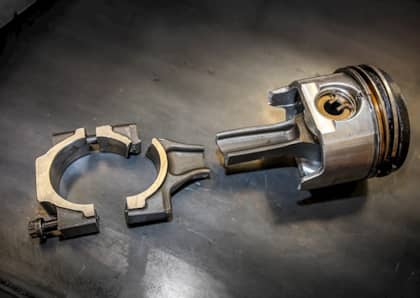Any Engine Can Fail, Part 2: Power Stroke Diesel Edition
As we showed you in the inaugural installment of our “Any Engine Can Fail” series, nothing is immune to random, unexplainable failure. Even engines that enjoy almost impeccable reputations for reliability can die unexpectedly and catastrophically. This time, we’re focusing specifically on Power Stroke diesels. And even though Ford’s 6.0L Power Stroke is often believed to have been the most problematic Power Stroke ever offered, two of the following four cataclysmic failures are owned by the coveted—and typically thought of as indestructible—7.3L Power Stroke. From bent connecting rods to cracked pistons to toasted rod and main bearings, there is plenty of Power Stroke carnage to take in here. Let’s get started.

Bent 7.3L Connecting Rod

If you leave a 7.3L Power Stroke alone to simply do its thing (i.e. don’t double its factory horsepower and torque rating), it will likely last at least 400,000 miles with proper maintenance. But if you play the big horsepower game you will eventually expose the 444ci V-8 diesel’s weak links. While the forged-steel rods found in ’94.5 to ‘00 engines and select ‘01 to ‘02 power plants are preferred over the weaker powdered metal rods, anywhere beyond 600rwhp and you’re asking for one or more of them to bend.
Forged Rod Vs. Aftermarket Rod In A Big Torque Application

Above, a forged-steel 7.3L rod that succumbed to the pressure inflicted upon it by producing more than 1,300 lb-ft of torque is positioned to the right of its superior replacement: a Pro Series I-beam rod from Manley Performance. Manley’s rods are manufactured from 4340 forgings, receive shot-peening after machining, are individually magnafluxed, come with 7/16-inch ARP2000 rod bolts and utilize AMPCO wrist pin bushings that won’t deform at high cylinder pressures. We’ve seen a 7.3L-powered truck pushed beyond 1,300rwhp (and 2,000 lb-ft of torque) with Manley rods in the mix.
Cracked Nozzle Carnage In A 6.0L

When the driver of a bone-stock F-450 with a 6.0L Power Stroke under the hood noticed an uptick in engine racket, a loss of power and excessive smoke leaving the tailpipe, he tried to limp his service truck 20 miles to the local diesel shop. The Super Duty never made it, and the result of trying to make it cost his company an engine. An analysis of the failure traced things back to a cracked injector nozzle, which as you can see here trashed an exhaust valve on top of damaging the combustion chamber area of the head.
Thermal Disintegration

After effectively torching the number 3 piston for 20-plus miles, this is what the piston directly below the cracked injector nozzle looked like: a melted hunk of cast-aluminum. The damage wasn’t contained within the number 3 hole, either. As the failure unfolded, debris made its way into neighboring cylinders, causing irreparable damage to piston numbers 5 and 7, along with additional cylinder head damage. This type of failure, where the injector nozzle cracked but didn’t break or blow off of the injector, could have been prevented by simply pulling over, turning off the engine and calling a tow truck.
7.3L Piston Skirt Failure

Despite the 7.3L Power Stroke’s stellar reputation for long-term durability, all of those high-mile, 20-year-old engines haven’t been able to outrun Father Time. As the miles continue to rack up and more and more age accumulates, an intermittent issue has surfaced with the 7.3L. The factory piston skirts can crack, oftentimes right beneath the bottom ring land. Due to broken skirts occurring in bone-stock and highly-modified engines alike, high-mile fatigue and casting flaws have been blamed for this potentially fatal failure.
Worst-Case Scenario

If conditions are right, this is the unfortunate end some 7.3L engines come to when a piston skirt breaks off. After the crack in the skirt spread within this 360,000-mile ’02 7.3L, a sizable chunk broke off and was beaten around in its cylinder. Notice the piece of rod bearing and the piston oil squirter… This engine was completely toast, and the block was unsalvageable.
A Neglected 6.4L Is A Dead 6.4L

Neglecting to perform routine maintenance on a diesel is something you might’ve been able to get away with in the days of old, but that won’t fly with today’s emissions-friendly engines. When an ’08 Super Duty was towed in with engine troubles, the shop doing the investigating found this: sludge rather than oil. Cutting corners by tripling the miles between oil changes and running an oil that was not CJ-4 rated in this 6.4L Power Stroke did not end well. Engine oil dilution is already a problem with the 6.4L due to the added fuel injected (on the exhaust stroke) during the engine’s regeneration cycles, which is part of the diesel particulate filter cleaning process. If anything, the oil in these engines should be changed ahead of the recommended mileage, not long after it.
Modern Day Diesels Are Extremely Hard On Engine Oil

As stated, the engine oil already faces an uphill battle in a 6.4L Power Stroke due to that application’s use of excess fuel being injected during the regeneration cycle. Diesel fuel is used to ignite the fire that’s required to convert soot trapped in the diesel particulate filter into ash, but in the process the percent fuel content (PFC) of the oil goes way up. Add to that an exhaust gas recirculation (EGR) system that’s perpetually allowing carbon and particle matter contaminants to reenter the intake tract and the engine oil further has its work cut out for it. The moving parts in any engine are only going to tolerate a lack of proper lubrication for so long before rod and main bearing failures begin to occur.
More From Driving Line
- The 6.4L Power Stroke has a rap sheet a mile long for major failures—and you can learn all about this engine’s blues right here.











